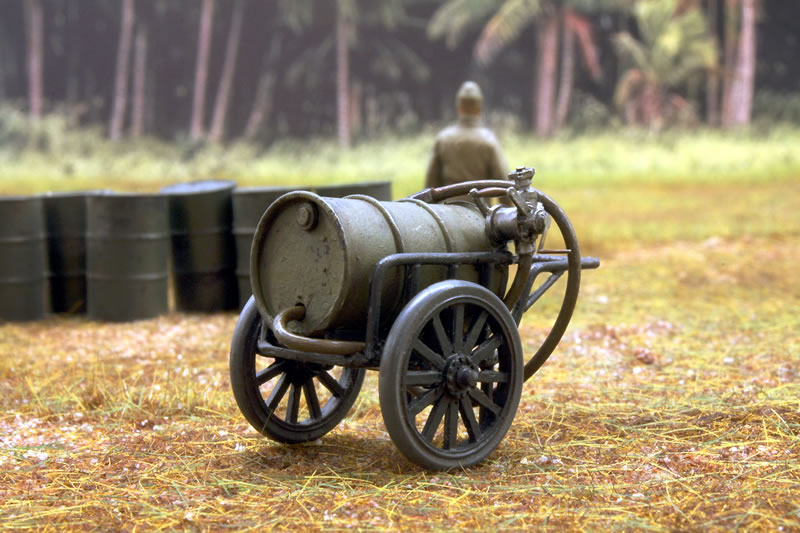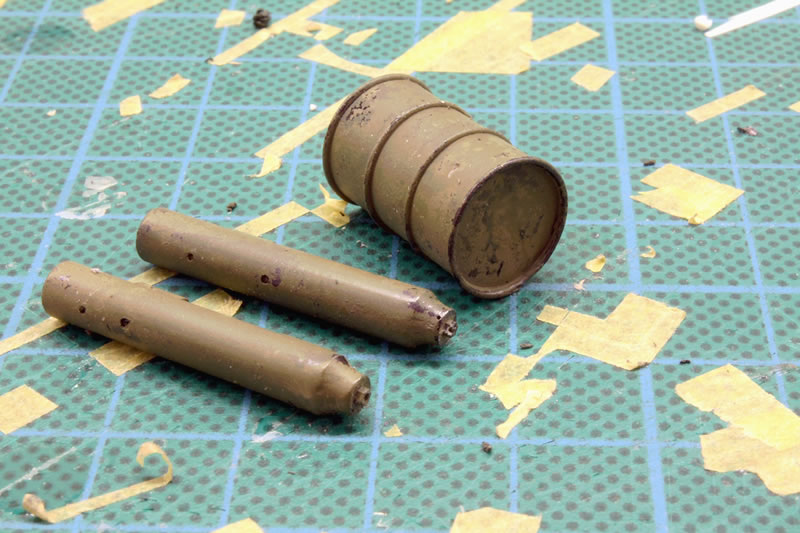Brengun's 1/48 scale
Japanese Airfield Equipment
by Roland Sachsenhofer
|
Japanese Airfield Equipment |

A statement at the beginning: when purchasing these two kits, it is not so much the fascination for the respective prototypes that is in the foreground, but rather their modelling possibilities. Presumably, most miniatures of this Japanese tanker and the fire wagon respectively will be used as requisites for a diorama. My approach is similar, but differs in one essential point: my interest is not in building dioramas, but in providing a photographically interesting background for my aircraft models.
A few words about the use of requisites in model photography
One of the goals I pursue when photographing models is to achieve the greatest possible depth of field: from nose to tail, from wing tip to wing tip, the aircraft should be as sharp as possible throughout. This minimises the impression of a model and makes the aircraft appear "big" in a relatively reliable way. The main reason for this is that, due to the conditions of the optics, aircraft-sized objects, when photographed from a distance where they can be seen in their entirety in the photo, are shown in sharp focus in their entire depth. This impression is reinforced if the horizon line of the picture - and thus the apparent eye level of the viewer - is set appropriately close to reality.
But what does this have to do with the little tank and the fire extinguisher? The possibility of positioning objects in front of and behind the model increases the spatial depth and thus also the impression of the apparent size of the model depicted. By using a low-lying horizon line, it is also easy to arrange objects in front of or behind the aircraft in such a way that the objects overlap in the image; this can further increase the degree of apparent realism.

In addition, the possibility to distribute objects in the image space also offers the opportunity to perform image composition. For example, visually emphasising the lower corners of the picture usually creates a balanced overall impression. By arranging and aligning accessories, it is also possible to create visual directions in the picture format that frame the actual protagonist, the aircraft, so to speak, and guide the viewer's gaze through the picture - entirely according to the will of the designer.
In summary, it can be said that the use of requisites can really "spice up" model photos! Equipment such as the fuel tank or the fire extinguisher are of course interesting for other reasons as well: here the imagination of the model maker can run wild, as the specifications for appearance or colouring are usually not quite as strict as is the case with aircraft models.
I have no information on the history and origin or even the manufacturer of the two devices, although I do not doubt that the motivated modeller could easily obtain the relevant facts. Even though my interest is in the aircraft, dealing with the two devices has once again made it clear to me how much infrastructure had to be conceived, developed and provided in order to operate these aircraft. This, too, would undoubtedly be a fascinating and stimulating field!

Whether from this technical-historical perspective or from that of the requisiter and designer of a diorama: the occupation with the "all-round" of flight operations can be astonishingly rewarding!
The manufacturer Brengun puts mostly usable and cleanly cast resin material into the attractive packaging. The word "mostly" already indicates two limitations of an otherwise very positive overall impression!
Firstly, some of the resin parts are simply not usable in my opinion. This criticism refers especially to the representation of the numerous parts of hoses, which, frayed and uncleanly cast, already break when detached from the cast block. This is unnecessary in the literal sense of the word, because in my opinion it is much easier to depict the hoses with appropriately improvised solutions such as electric cables or similar. All visible hose sections and most of the connections on both models are therefore made of appropriately dimensioned cable insulation.
On the other hand, there are also some parts in both kits that have been cast very badly and have to be brought into shape. I am especially referring to the four wheels of the two vehicles, whose wheel hubs and spokes are sometimes badly scarred and defective. The need for shaping and cleaning, however, runs through all the components.
I have tried to make the traces of a long period of use visible on tank trolley, such as fire extinguishers, which, in addition to damage to the coating, also includes dirt. After priming, the surfaces were covered with a layer of "Alclad Gunmetal". Maskol dabbed on top of this served to prepare the representation of paint chipping. Finally, both pieces of equipment were washed before traces of dirt were applied with pastel crayons.
Both tools are now waiting in my fundus to be used in one or the other Japanese scenario. In any case, I am just as happy about the expanded photographic possibilities of future aircraft photos as I am about the broadening of my horizons that the occupation with this subject, which was foreign to me, has brought me!
If you are interested in the building process, please have a look here on Scalemates:
https://www.scalemates.com/profiles/mate.php?id=10148&p=albums&album=93143
As ever, remarks will be appreciated:
ro.sachsenhofer@gmx.at
Model, Images and Text Copyright ©
2023 by Roland Sachsenhofer
Page Created 26 April, 2023
Last Updated
26 April, 2023
Back to HyperScale Main Page

|
Home
| What's New | Features | Gallery | Reviews | Reference | Resource Guides | Forum |